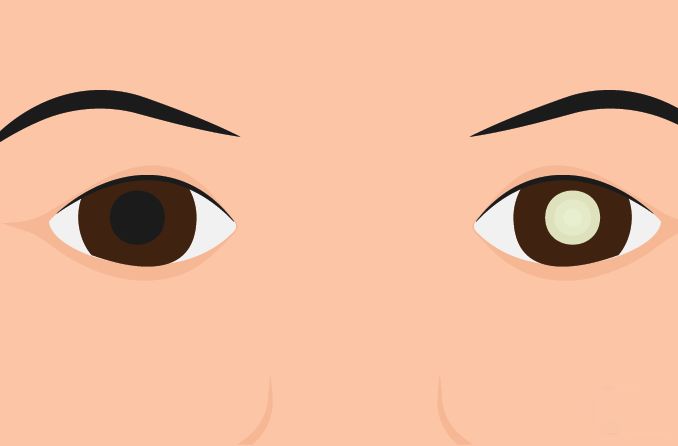Photos may help detect eye diseases in your children

Photos are meant to memorialize special family moments, but every once in a while, a picture captures evidence of eye diseases in a child, revealing the need for medical treatment.
What to look for in a photo of your child? Look for a white or yellow glow in one eye.
Doctors refer to this as abnormal red reflex, and it appears when the flash of a camera causes a reflection to bounce off of a misplaced or foreign object in the eye (such as a tumor) that is blocking or impeding the child’s optical pathway.
Misalignment of the eyes, a classic feature of these conditions, can also play a role.
Normal red reflex, on the other hand, is indicated by two red eyes, and is generally not cause for concern. Not medically speaking, anyway — for aesthetic reasons, who doesn’t prefer photographs without the “red eye effect”?
SEE SOMETHING WORRISOME IN PHOTOS OF YOUR CHILD? Book an appointment with a pediatric vision specialist near you.
Signs of some childhood eye diseases seen in photos
Photos of your child could show signs of these eye diseases (among others) in youngsters:
Coats disease is an ailment characterized by abnormal development of the blood vessels in the retina. Symptoms include a white pupil (or leukocoria), crossed eyes and vision loss. Eventually, Coats disease can lead to glaucoma, cataracts, retinal detachment and blindness.
Retinoblastoma, a type of eye cancer that frequently involves an inherited genetic mutation, begins when malignant cells develop in the eye’s retinal cell layer. In addition to abnormal red reflex in photographs, symptoms include pain, crossed eyes and impaired vision. The cancer is treatable, with a cure rate of more than 90%, according to the American Cancer Society, but early detection is critical.
Cataracts, which are rare in children, are described as the clouding of the eye’s lens. Cataracts, when left untreated, can prevent a child’s eyes from properly developing. Serious long-term consequences, including blindness, are possible.
Congenital toxoplasmosis is a parasitic infection that can pass from mother to fetus (the mother is often asymptomatic). The infection causes retinal inflammation and usually resolves on its own without complications, according to the American Academy of Pediatric Ophthalmology and Strabismus. However, congenital toxoplasmosis can leave a scar. The scar is unlikely to impact vision, but it can cause abnormal red reflex in photographs.
Strabismus is the clinical term for being cross-eyed. Coats disease, retinoblastoma and cataracts all can cause strabismus, but strabismus alone isn’t necessarily a sign of disease. Absent of other medical issues, the condition can be corrected with glasses and/or surgery.
Numerous other conditions, including Persistent Fetal Vasculature, other types of infections and tumors and trauma to the eye can also cause abnormal red reflex in photographs.
SEE RELATED: What is a pediatric ophthalmologist?
Abnormal red reflex in your child’s photo
If you snap a photo of your child and later notice that one eye is glowing bright white or yellow — don’t panic, says Dr. Aaron Miller, a pediatric ophthalmologist in Houston and clinical spokesman for the American Academy of Ophthalmology (AAO)
The problem could be (and often is) as simple as a difference in prescription level between the two eyes, a problem easily solved with a pair of glasses. It could also be nothing. It could even be a camera-related fluke, or the direction in which your child was gazing when the photograph was taken.
Instead of immediately assuming the worst, Miller recommends looking for consistency. Do you see abnormal red reflex in every photo, or is it just one isolated instance?
“If it is a single photo, and all other photos seem to appear normal, that would maybe be less concerning,” Miller says. “But if it is a recurring thing that is being noted in several photos, the first recommendation would be that families contact their pediatrician.”
The pediatrician will check for red reflex abnormalities in the child’s eye with a tool called an ophthalmoscope, Miller says. A healthy pair of eyes will be symmetrical, and the ophthalmoscope will show two red eyes.
Anything other than that will warrant further investigation, and your child may be referred to a pediatric ophthalmologist for additional tests and/or imaging. Be sure to bring the suspicious photos (in digital or print form) to your child’s exams so the doctor(s) can take a look.
“Most of the time, everything is normal,” Miller says. “But you don’t want to miss that (rare occasion) that it isn’t.”
Check your camera
Before heading to the doctor’s office, check your camera’s settings are optimal for capturing normal red reflex (this can help ease your mind, and it will also allow you to check for that needed consistency across photographs Miller referenced).
The AAO recommends making sure photo subjects are looking directly into the camera’s lens. You should also turn off the red-eye reduction setting, and turn on the flash.
A smartphone app, too, may help you to spot abnormal red reflex in photos of your child, A 2019 study found that CRADLE, an app recently developed Baylor University scientists, is able to successfully detect incidences of abnormal red reflex in up to 80 percent of cases.
“I think (CRADLE) is a very useful tool,” Miller says, adding that regardless of what the app indicates, a child with abnormal red reflex in photos should always be examined by a doctor. “But, right now, we are not at the point where we can rely on the app alone.”
CONCERNED ABOUT ABNORMAL RED REFLEX IN PHOTOS OF YOUR CHILD? Book an appointment with a children’s eye doctor near you.
Page published on Sunday, May 17, 2020




